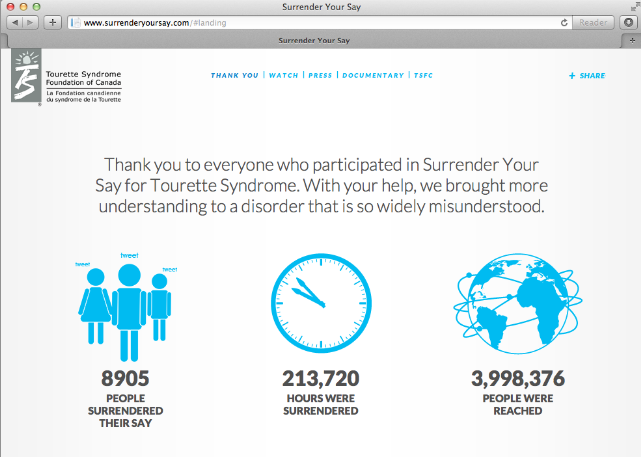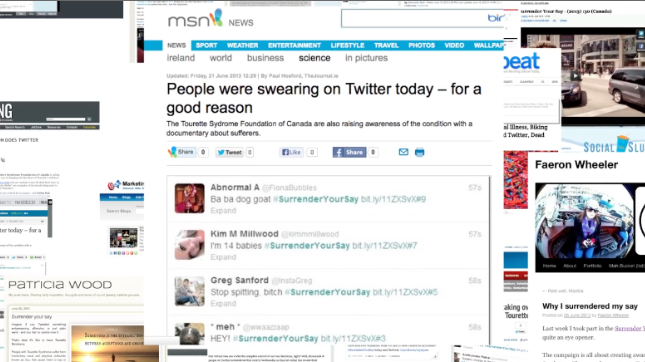Surrender Your Say – Twitter Campaign for Tourette Syndrome
Events, Seasonal and Short-Term (GOLD)
Client Credits: Tourette Syndrome Foundation of Canada
Lynn McLarnon – Executive Director
Kirk O’Brien – Executive Board
Cathy Wylie – Executive Board
Doug Coll – Executive Board
Agency Credits: Saatchi & Saatchi Canada
Saatchi & Saatchi – Agency
Helen Pak – Co-Executive Creative Director
Brian Sheppard – Co-Executive Creative Director
Rachel Kennedy – Art Director
Shauna Roe – Writer
Lisa Hamilton – Digital Producer
Simon Conlin – Digital Producer
Sheraz Amin – Account Manager
Nick Moretta – Account Manager
Sarah Campbell – PR/Social
Michelle Orlando – Head of Production
The Development Factory – Digital Production
Suzanne Abate – Digital Executive Producer
Lindy Zucker – Digital Producer
Andrew Bodis – Developer
Editing – Bijoux
Sound – Boombox Sound
Visual Effects – Track and Field
Section I — BASIC INFORMATION
| Business Results Period (Consecutive Months): | June 2013 – July 2013 |
| Start of Advertising/Communication Effort: | June 2013 |
| Base Period as a Benchmark: | Calendar 2013 |
Section II — SITUATION ANALYSIS
a) Overall Assessment
Tourette Syndrome (TS) is a neurological disorder characterized by tics: involuntary, rapid, sudden movements or vocalizations that occur repeatedly in the same way. It is a complex, difficult disorder that manifests itself in many ways. But understanding of the true nature of the disorder is very low. Most people think Tourette is just ‘the swearing disease’, or that people suffering with it are crazy. The media hasn’t been any help, as TS is the butt of many jokes, from TV shows to Hollywood films. Entire youtube channels have been devoted to ‘The Tourette Guy’, a buffoon who swears indiscriminately for comedic effect. In truth, we’ve probably all heard – and maybe even told – a joke about Tourette Syndrome at one time or another.
To educate people about the true nature, the Tourette Syndrome Foundation of Canada (TSFC) had many obstacles to overcome. First, the disorder defies neat and tidy descriptions; its symptoms and their severity are varied, random and ever-changing. So trying to explain the disorder was going to be very challenging. Second, the TSFC had very little budget to start changing the tide of perception with a public that had largely already formed an image of what Tourette Syndrome is. Third, the TSFC is a small charity on the Canadian landscape, being dwarfed in size and budget by everyone from the Canadian Cancer Society to the United Way to World Vision. On two separate lists of top 100 Canadian charities, the TSFC doesn’t even appear [Footnote 1]. In an increasingly noisy charitable environment, the Foundation’s voice was practically non-existent.
To achieve their objectives of generating real, meaningful awareness of what Tourette Syndrome is really like, the TSFC launched the Surrender Your Say campaign in June, 2013.
b) Resulting Business Objectives
Three objectives were identified:
1. Generate awareness for Tourette Syndrome. The TSFC have no budget to properly measure current brand awareness, so conclusions would be drawn by looking at the engagement numbers and the conversations that started online and in the media as a result of the campaign (targets listed below in points 2 and 3).
2. Generate Strong Participation in Social Media. The campaign that the TSFC undertook required people to give up their twitter feed for 24 hours – which is an enormous thing to ask. The TSFC hoped to sign up 1000 people for Surrender Your Say before launch, and then recruit another 3000 during the 3 day campaign. Additionally, The TSFC hoped to reach 1 million of their followers and generate 20 million social media impressions during this period. It was also hoped to trend on Twitter in as many countries as possible.
3. Generate Publicity for the TSFC. Because TS has little or no public profile, another objective was to generate publicity for the TSFC and its efforts. Specific objectives were to get media coverage by news organizations and bloggers, and to get at least one major celebrity to create buzz by tweeting about the campaign.
c) Annual Media Budget
$100,000 – $200,000
d) Geographic Area
Primary – Canada
Secondary – Worldwide
Footnote 1: http://www.moneysense.ca/2010/06/17/the-charity-100/
http://www.charityintelligence.ca/major-100-charities
Section III — STRATEGIC THINKING
a) Analysis and Insight
Through over three decades of representing Canadians with Tourette Syndrome, the TSFC had come to learn one important thing: the more people are aware of what TS really is, the more they accept those who are suffering with the disease. They knew that understanding lead to empathy and acceptance.
Unfortunately, explaining the complexities, randomness and variance of Tourette Syndrome is incredibly hard – because it often defies explanation.
This led to a true ‘a-ha moment’: For people to truly understand the disorder, they need to experience it first hand.
The target was anyone who misunderstood Tourette Syndrome. Because there was no budget, this required a big idea delivered in an innovative way.
b) Communication Strategy
Of course, just saying that people should experience Tourette Syndrome is one thing. Actually finding an effective way to do that is quite another. The very nature of nature of TS provided the answer. TS has many symptoms that can come or go and weaken or strengthen in random, unpredictable ways. This makes living with TS incredibly challenging – particularly for people with vocal tics. After all, imagine blurting out random and even obscene words at any moment, in any situation – it’s a feeling of deep frustration and anxiety. This directly influenced our strategy, which was use the negative power of random, unpredictable, embarrassing vocal outbursts as a way to generate awareness.
Knowing this led to the the big idea: the TSFC would give people Tourette Syndrome – on Twitter.
Twitter is the online equivalent of walking down a busy street. You are judged by what you say – and if you say strange or offensive things at random, you risk being excluded and ostracized. People with TS live with this sense of anxiety and marginalization every day.
The TSFC challenged the pubic to experience these feelings by giving up the their twitter feeds for 24 hours. Through social media and donated TV, the TSFC seeded the idea with a hope to get 1000 people to sign up for the launch on June 19, 2013. The program was called Surrender Your Say.
When people joined Surrender Your Say, they would allow the TSFC to randomly tweet Tourette tics directly into their Twitter Feeds. Participants would have no idea what they would be, or how many there would be. But they knew the tweets were taken from real people living with TS – so they’d be weird, non-sensical and potentially very offensive. And they would have no control over them. In this way, they would truly experience what living with Tourette Syndrome is really like.
Section IV — KEY EXECUTIONAL ELEMENTS
a)Media Used
The primary medium was Twitter. That is where the tweets – and the ongoing conversation – would take place.
To prelaunch the campaign, a simple :30 television ad was created that ran on donated TV media in the weeks prior to launch.
b)Creative Discussion
The strategy led directly to the creative idea, and the way it was executed. By using Twitter to mimic every day speech – and then subverting that medium in a shocking and unusual way – the TSFC were actually able to get people to feel what it’s like to experience the anxiety and isolation of Tourette Syndrome.
Several things made Surrender Your Say stand out to the target. First, it was a completely new and unique way of using Twitter – something Twitter themselves acknowledged (in fact, Kirstine Stewart President and CEO of Twitter Canada, tweeted on behalf of the project.)

Second, it was the first time that the chosen media – Twitter – was used to actually mimic a medical disorder and let people experience it firsthand. When many people saw the offensive and strange tweets, they were initially shocked… but this shock immediately melted away once they realized this was in support of Tourette Syndrome. This is exactly the effect the TSFC want to happen in real life.
c)Media Discussion
Because of the constraints of budget, and the competitive pressures of fighting for not-for-profit media space against other charities, online was chosen as the primary media instead of mass.
Media choice was critical to the idea, because for the first time Twitter was used to mimic the symptoms of a medical disorder. It was very visible, and allowed for the idea to proliferate freely. It also allowed for valuable conversations to take place about the Surrender Your Say campaign, and the nature of Tourette Syndrome itself.
Because the medium was being used in a new and unique way, it was hoped this would be noticed and reported on by the conventional news media. And indeed this was the case.
Section V — BUSINESS RESULTS
a) Sales/Share Results
The results of the three day campaign were very impressive.
1. Generate Public Awareness of Tourette Syndrome. The campaign created a global conversation about TS in a variety of mediums, generating massive awareness for the disorder. Specifically, people truly understood the nature of the disorder thanks to the campaign.



2. Generate Strong Participation in Social. Over 1500 people signed up pre-launch (1.5x goal.) In three days, nearly 9000 participated (3x goal). SYS tweets reached nearly 4 million of the participants’ followers (4x goal), demonstrating that we attracted powerful social influencers. Visits to the TSFC website were up 300% during the campaign period. The campaign generated a staggering 100 million impressions (5x goal) – not including impressions generated by the thousands of Twitter comments about SYS, or the PR that it picked up.

3. Generate Publicity for the TSFC. The campaign was reported on by dozens of news outlets including CNN, The Globe and Mail, The National Post, The CBC, Huffington Post and CTV News.

#surrenderyoursay trended organically for 2 days in Canada, France, Australia and many other countries.

And the campaign attracted powerful celebrity influencers, with tweets and re-tweets by Rick Mercer, Howie Mandell and Stephen Fry. Several participants were listed on the Forbes Top 50 Social Media Influencers.


b) Consumption/ Usage Results
c) Other Pertinent Results
d) Return on Investment
Section VI — CAUSE & EFFECT BETWEEN ADVERTISING AND RESULTS
a)General Discussion
All of the results discussed above were generated after the Surrender Your Say campaign was launched, and within days of implementation. In the mind of agency and client alike, the goals that were achieved were a direct result of the project.
During the campaign period, Tourette as a theme went from virtually no mentions on Twitter to a subject that literally tens of thousands of people were talking about. Press interest in the TSFC and Tourette Syndrome also exploded during the campaign period. This suggests a direct causal link between the campaign and the results.
b)Excluding Other Factors
Spending Levels:
Becuase this was an awareness campaign for a charity with a budget of $0, pricing was not a factor in the campaign’s success.
Pricing:
As this is a charity awarness campaign, pricing was not a factor in the success of the campaign.
Distribution Changes:
Does not apply.
Unusual Promotional Activity:
No unusual promtotional activity took place before, during or after the campaign.
Other Potential Causes:
No other communications or initiatives factored into the success of the Surrender Your Say Project.
This was the first major, national communications initiative launched by the Tourette Syndrome Foundation of Canada in over 2 years, so none of its achievements have been the result of a carryover effect from previous campaigns.